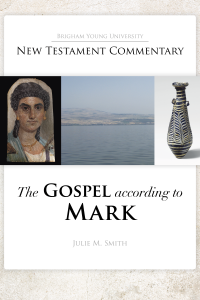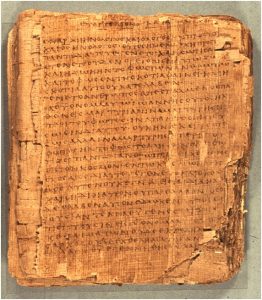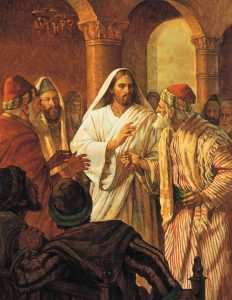
Sea of Galilee
Excerpted from The Gospel according to Mark, by Julie M. Smith.
The Gospel of Mark is formally anonymous, meaning that the name of the author does not occur within the text (contrast Rev. 1:1). The writer may not have felt any need to include his or her name, being well known to the community or may have omitted a name for rhetorical reasons, perhaps to focus the text on Jesus Christ instead.[1] The author does not claim to be a follower of Jesus, an eyewitness to his ministry, or to have any specific personal connection to the people in the Gospel.[2] Nothing indicates how the author learned the stories that are in the Gospel. Apparently, the author did not think that the reader needed to know his or her name or connection to Jesus’ life. This has not stopped scholars from trying to figure out as much as possible about who wrote the Gospel.
The first clue is the title. The Gospel was likely originally without title since “in ancient book production and publication, the title belonged more to the stage of reception than to that of production.”[3] Perhaps the Gospels were initially without titles because the titles would have been obvious to all readers, because the authors hoped to avoid persecution from having their names associated with Christian writings, or because they did not consider the text their unique creation but rather a communal project. It may have been that a title was only added after other Gospels were written and it became necessary to distinguish them. Or a title may not have been necessary until the Gospel circulated beyond its original location.[4]
The title of Mark’s Gospel is very old, but it is not attached to all ancient manuscripts. It was most likely added in the late first century or early second century, although there were some copies even in the fourth century that did not have a title.[5] The oldest manuscript of the second Gospel does not have a title, although many other manuscripts from that era do contain titles.[6] The title is likely to date from before the mid-second century because by then Gospels were normally attributed to apostles to increase their authority and prestige. Presumably, had a title-less Gospel of Mark been circulating and someone had decided to give it a title at that point, it would have been given the name of an apostle.
Because the title appears at the beginning, the end, the side, or both the beginning and the end, depending on the manuscript, it seems that the title was not there originally but was added later and thus placed in a variety of locations. The fact that the only author associated with this text is Mark is an indication of the accuracy of the attribution; by contrast, Galen, a second-century physician, had an untitled work that was later given more than one title, which is precisely what one would expect to happen if many different hands were generating a title for a book.
There is a curious situation regarding the title of this Gospel in the Joseph Smith Translation: while Latter-day Saint Bibles indicate in the footnotes that the JST titles the book “The Testimony of St. Mark,” this is apparently an error; the JST does change the titles of Matthew and John from “The Gospel of ” to “The Testimony of,” but apparently the titles of Mark and Luke were not changed. Some Latter-day Saint scholars conclude that the title change, limited to Matthew and John, reflects their apostolic status.[7]
So there is very good—but not airtight—evidence that the author of this Gospel was named Mark. Unfortunately, “Mark” was one of the most common male names in the Roman Empire.[8] (It was, however, rare for Jews.[9]) What else can be known about him? Some characteristics of the author can be deduced from the text, although most of these conclusions are not without counterpoint:
- Latinisms. Mark’s use of Latin terms[10] suggests that (some of) the audience was more familiar with Latin than Greek, especially since there are two occasions when Greek words are explained in Latin terms.[11]
- Aramaic Words and Phrases. Mark’s Gospel contains a surprisingly high number of Aramaic terms[12] for a text of its length. In all cases, these are translated into Greek, leading to the conclusion that the author, but not (all of ) the audience, knew Aramaic.
- Geographical Descriptions. Some scholars find errors in Mark’s descriptions of geography,[13] which might indicate a lack of familiarity with Palestine. (Other scholars point out that ancient people would not have known their own geography nearly as well as those who have access to maps.[14]) On the other hand, it is likely that Mark is more concerned with theology than geography and therefore adapts the physical setting to fit the rhetorical needs.
- Understanding of Judaism. Mark explains some Jewish customs. Traditionally, it was assumed that this was because Mark (but not the audience) was familiar with them.[15] Alternatively, some scholars feel that these descriptions show a limited understanding of Judaism,[16] perhaps implying that Mark was not Jewish, but this is disputed,[17] especially since Mark contains many biblical allusions. It is also possible that these descriptions are provided for dramatic effect and not because they provide new information to the audience.[18]
- System of Timekeeping. In 6:48 and 13:35, Mark uses the Roman system of four watches per night, instead of the Jewish reckoning of three watches per night, to delineate time, perhaps serving as further evidence for a Roman setting of the Gospel. But it is also possible that Mark used Roman time either in order to make the text understandable to gentile audience members, or because he or she was not being precise, or perhaps because Jews used the Roman system as well.
- Writing Style. Mark’s Gospel is written in very poor Greek.[19] For example, in 16:6, the word “behold” is in the singular form despite the fact that more than one person is being addressed. It can be difficult to evaluate what some of this evidence implies about Mark, and scholars draw opposite conclusions from it. Perhaps it is safe to say that the data suggests that the author knew (at least some) Aramaic, knew Greek (but wrote it poorly), was likely to have been a Jew, and is associated with Rome.
[1] It is theoretically possible that the author of Mark was female, but given the extremely low rates of female literacy in the ancient world, this is unlikely.
[2] Older scholarship often associated the author of the Gospel with the young man who flees when Jesus is arrested in 14:51, but this is unlikely. The association probably stemmed from a desire to explain the function of the young man in the narrative, but there are now better readings of this enigmatic character. See the Notes on that verse for more information.
[3] Collins, Mark, 129.
[4] For a general discussion of Gospel authorship from a Latter-day Saint perspective, see Frank F. Judd Jr., “Who Really Wrote the Gospels? A Study of Traditional Authorship,” in How the New Testament Came To Be: The Thirty-fifth Annual Sidney B. Sperry Symposium, ed. Kent P. Jackson and Frank F. Judd Jr. (Provo, Utah: Religious Studies Center; Salt Lake City: Deseret Book, 2006), 129–30.
[5] Marcus, Mark 1–8, 17.
[6] Collins, Mark, 3.
[7] Barney, “Joseph Smith Translation,” 88.
[8] Marcus, Mark 1–8, 17.
[9] David E. Garland, A Theology of Mark’s Gospel: Good News about Jesus the Messiah, the Son of God, ed. Andreas J. Köstenberger (Grand Rapids, Mich.: Zondervan, 2015), 50.
[10] Latinisms in Mark’s Gospel include legion (5:9, 15), speculator (KJV: “executioner”; 6:27), denarius (KJV: “penny”; 6:37; 12:15; 14:5), quadrans (KJV: “mite”; 12:42), flagellare (KJV: “scourge”; 15:15), praetorium (15:16), and centurion (15:39, 44, 45). See also Stein, Mark, 11–12.
[11] “Two mites, which make a farthing” (12:42); “the hall, called Praetorium” (15:16).
[12] “Boanerges, which is, The sons of thunder” (3:17), “Talitha cumi; which is, being interpreted, Damsel, I say unto thee, arise” (5:41), “Corban, that is to say, a gift” (7:11), “Ephphatha, that is, Be opened” (7:34), “hell, into the fire that never shall be quenched” (9:43), “Bartimaeus, the son of Timaeus” (10:46), “Abba, Father” (14:36), “Golgotha, which is, being interpreted, The place of a skull” (15:22), “Eloi, Eloi, lama sabachthani? which is, being interpreted, My God, my God, why hast thou forsaken me?” (15:34).
[13] In 5:1, the earliest texts of the Gospel have the pigs running 35 miles (!) to “Gerasa.” Later texts read “Gadara,” but that area has no cliffs (Stein, Mark, 250). In 7:31, the journey from Tyre to the Sea of Galilee by way of Sidon is an unnecessary detour (Stein, Mark, 357). In 11:1, a similar “detour” is described (Stein, Mark, 503).
[14] Collins, Mark, 8.
[15] For example, washing customs of Pharisees (7:3), explanation of the Passover (14:12), and preparation for the Sabbath (15:42).
[16] Mark 15:42 can be read to suggest that Mark did not understand that the Sabbath began at sundown, therefore preparation for the Sabbath would not have occurred during the evening as that would have already been considered the Sabbath; Luke 23:56 may be a commentary on this (see Marcus, Mark 1–8, 20). Mark 1:2 (which ascribes quotations from Isaiah and Malachi to Isaiah only) and 2:26 (which names Abiathar as the high priest when the high priest was Ahimelech [see 1 Sam. 21]) may show a lack of familiarity with Jewish scripture (although there are other explanations for these “mistakes”; see the Notes on each verse).
[17] For example, 7:3–4 (washing customs of the Pharisees) is widely regarded to be erroneous, but some disagree with this assessment. Marcus, Mark 1–8, 20.
[18] For example, the description of Judas as one of the Twelve in 14:10 does not provide the audience with new information but rather serves to emphasize Judas’ treachery. Similarly, the description of Jewish custom in 7:3–4 may not be new information to the audience but rather serve to emphasize the reliance on the tradition on the elders and the absurdity of washing dining couches.
[19] To the extent that the KJV translation sounds refined and elegant to modern ears, it does not represent Mark’s writing style.
 Our commentaries contains our “New Rendition,” which is a new version of the New Testament text. We’re offering it free as ebooks via Kindle and Deseret Bookshelf. So far we have Mark, Luke, First Corinthians, and Revelation. Here are the links.
Our commentaries contains our “New Rendition,” which is a new version of the New Testament text. We’re offering it free as ebooks via Kindle and Deseret Bookshelf. So far we have Mark, Luke, First Corinthians, and Revelation. Here are the links. 




